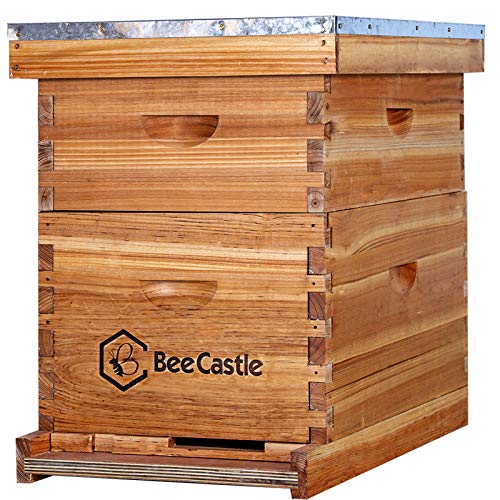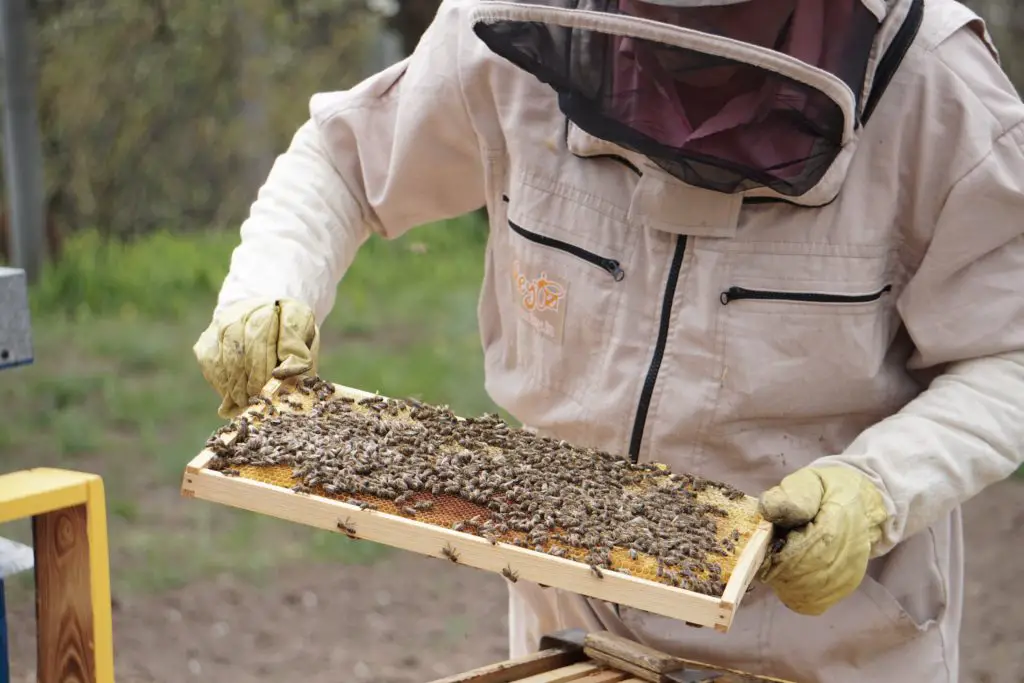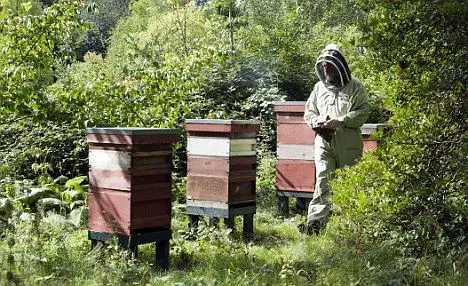Affiliate Disclaimer - As an Amazon Associate I earn from qualifying purchases.
It supports the website. So, Thank you
If you have decided to give yourself a DIY project and build your own beehive then that’s great; it’s certainly a rewarding process. But you will need to make sure that you choose the right materials so that your hive is strong, sturdy and provides the right level of protection for the bees.
Plywood is much more affordable which is why a lot of people wonder; can you use plywood for beehives?
Unfortunately, while inexpensive, plywood isn’t the best type of material for building a beehive. It has small gaps that can reduce insulation and the glue used to hold the boards together may be damaging to the bees. Some plywoods are glued with glue containing formaldehyde. What’s more, it’s not as weather resistant so the hive won’t last as long.
But don’t worry, there are many types of wood that are ideal for building beehives and in this guide, we’ll run through some of the best options.
Why You Shouldn’t Use Plywood For A Beehive
A lot of beekeepers are very fussy about using wood with knots in as these can affect the aesthetic and make it more difficult to join pieces together if a knot is in the way. However, these same beekeepers will relish the idea of using plywood for their hives and this is much worse than using a bit of knotty pine.
Plywood might be affordable and it does have some great uses, but not when it comes to building a beehive. The problem is that plywood is several boards that are glued together. There is some suggestion that this glue can be detrimental to the bees’ health and you want to provide as natural an environment as possible.
What’s more, plywood won’t stand up very well to the elements, even if you treat it. Compared to a solid board, plywood will really be battered by humidity and moisture. This will mean that your beehive doesn’t last as long. But more importantly, you have to consider that there will be small gaps between the boards and this means that air can get through. It’s essential to make sure that a beehive is well insulated, especially in the colder winter months and these gaps could mean the difference between a colony that survives winter and one that doesn’t.
Not to mention that these gaps could also be the perfect nook for diseases and pests like ants so it’s best to avoid this material altogether.
What Wood Is Best For Building A Beehive?
While plywood might not be the best choice, there are lots of solid boards you can use to build your beehive. There are some woods that are far more common in beehive making but these are certainly not your only choices.
Many people choose wood based on durability as this is one of the most important factors. However, some beekeepers will also choose cost-effective woods. You also need to consider that there will be different availability depending on where you live so doing some research on what’s locally available is a good idea before you get started.
With that in mind, let’s explore some of the best types of wood for beehives.
Pine
When it comes to making a beehive, pine is perhaps the most obvious choice. This is one of the most widely used materials and the great thing about it is that there are pretty much endless supplies. No matter where you live, you’ll likely be able to get your hands on enough pine to build several beehives and still have wood left over.
Another reason that so many people choose to use pine for their beehives is that it is so inexpensive. You’ll also find that it’s really easy to work with so if you don’t have a lot of experience with woodworking then this is a great material to start with.
You will need to keep in mind that there are two types of pine to choose from; knotty pine and clear pine.
Knotty pine is sometimes called standard pine and this is the most affordable of the two types. As its name suggests, there are knots in this type of pine as well as other imperfections. However, this is great if you are looking to make a rustic-looking beehive.
That said, you will need to remember that the knots can sometimes get in the way when joining pieces of wood together. This means that you’ll probably need to order more than your beehive plan calls for. If you find that one piece has a knot in the way, you’ll have enough stock to choose an alternative piece.
Clear pine which is sometimes called premium or select pine is much more expensive. And that is because this type of pine doesn’t have any imperfections and is completely free from knots. You’ll notice that the wood grain is also much straighter and tighter so it generally has a much nicer appearance. If you want something that’s going to look high-end and modern then this is probably the best type of pine to go for.

Cedar
One of the things that attract a lot of people to cedar is the fact that it looks incredible. It’s also got a beautiful aroma which is never a bad thing. Cedar is also very resistant and this is because of its natural oils which ensure that the wood doesn’t warp. Moreover, the presence of these oils means that the wood is less prone to bugs and pests.
Cedar is brilliant for outdoor use as it is highly unlikely to rot, especially when compared to other types of wood. Being naturally durable, you can simply knock the hive together and put it outside with no need to paint. That said, if you want to paint it then there’s no reason that you can’t but the wood will stand up to the elements without treatment.
When compared to something like pine, cedar does come up a lot more expensive. This is probably one of the main reasons that it isn’t as popular. For all of its amazing qualities, it’s likely that almost every beekeeper would choose it if it weren’t for the cost.
If you do want to use cedar then you will need to think about the variety. There are several to choose from but how easy it is to find them does depend on where you live. In the US, you’ll more often than not come across western red cedar.
Spruce And Fir
Like pine, spruce and fir and types of conifers. The main difference is that spruce and fir are usually associated with stud lumber whereas pine is board lumber.
If you look at hive plans online, you will find that many of these call for fir or spruce studs. It doesn’t really matter which you use as they’re pretty much the same and both kinds of wood have extremely similar properties.
These woods are beautifully easy to work with and are lightweight. Some types of spruce are prone to absorbing moisture whereas others will resist this well. It’s important to talk to your supplier to make sure that you get the best type of spruce or fir for outdoor use.
Generally speaking, however, these types of wood are reserved for the framework.
Cypress
Just like cedar, cypress has naturally occurring oil that adds to its resistance. This oil has sap-like qualities and is brilliant for repelling insects. It also means that this type of wood is far less prone to things like mould which can then lead to rot.
If you’re looking for one of the best types of wood for a beehive then cypress is right up there. It is an incredibly durable species and it really does look great. However, one of the main problems with cypress is that it is not as readily available across most of the USA.
Exotic Woods
Exotic woods are, for the most part, a lot more expensive. But as they say; you get what you pay for. If you’re looking to make a breathtaking beehive that can be a talking point of your garden then choosing exotic wood will certainly help you to achieve that.
Cherry is a popular type of exotic wood that is often used to make kitchen cabinets. But there’s nothing stopping you from using it to make a stunning beehive.
If you’re a keen woodworker then you might turn to make beehives into a hobby. You can then sell your products to make a little extra cash. What’s super exciting is that there have been reports of African mahogany beehives selling for as much as $1500!
Black walnut is a great choice if you want to use exotic wood. This wood is often used to make fine furniture so you’ll get a similar effect when making a beehive.
The one thing to keep in mind when using exotic wood is that, while the hives will look the part, this wood isn’t going to improve their function at all. Yes, some types of wood will be more durable than others but that’s about the extent of it.
Moreover, you should consider that the bees really aren’t going to be fussy about what material the hive is made from. They’re going to be just as content in a knotty pine hive as they would be in a top-of-the-range mahogany one.
Can You Use Synthetic Wood For Beehives?
Synthetic wood? Surely that can’t be right? Well, in this day and age you can get your hands on just about anything so when it comes to using wood, you don’t even have to use the real thing.
But what is synthetic wood? It’s a man-made material that is formed through blending a variety of recycled plastics and wood fibers. What’s great about it is that it is eco-friendly and since many of us are trying to do our bit for the planet, this is something that appeals.
What a lot of people love even more about synthetic wood is how low maintenance it is. With real wood, you need to treat it regularly, especially when it is used outdoors to prevent it from rotting. However, synthetic wood pretty much takes care of itself. All you need to do is make the hive and it’ll resist the weather and won’t ever rot.
That said, while this material certainly does have a lot of good points, there’s still no real suggestion that it’s ideal for making a beehive. One of the major issues you will face if you use this stuff is that it doesn’t come in the same lumber sizes as wood which can make things a little more difficult. Moreover, synthetic wood is surprisingly heavy and you’ll pay quite a lot for the amount you’d need to build your hive.
Are There Any Woods I Should Avoid For Making A Beehive?
If you’ve done any research online about the best wood to build a beehive then you may have seen some beekeepers talking about woods that you shouldn’t use. This is because of the belief that they are toxic to the bees. Of course, nobody wants to harm their bees so it’s important to consider this.
Most people would tell you that black walnut might be toxic to bees but there is no real evidence to suggest this. Moreover, there is no evidence that says any type of natural wood would cause harm to the bees so much of this is speculation. Of course, you can be on the safe side and avoid things like black walnut if it gives you better peace of mind.
But, there could be some woods that are toxic to you when you are making the hive and this is as a result of the sawdust that comes off of them. Black walnut is, in fact, one of the culprits here as are things like cedar and mahogany. Again, none of these woods should cause any harm to the bees.
The sawdust from these woods can cause a variety of problems, especially in those who have breathing conditions such as asthma. For this reason, if you do decide to work with them, it is vital that you use the correct safety equipment. This might include things like a respirator and of course, making sure that you work in a well-ventilated area.
Overall, the chances are that any type of wood you can get will be suitable for building a beehive. There are pros and cons to each that you’ll need to consider but largely it comes down to personal choice.
Check Out These Beehive Kits
Conclusion
One of the first things you will need to do when you start beekeeping is getting a hive for your colony. While you can buy ready-made hives, it is rewarding to build your own. You will need to choose the right material for your beehive but can you use plywood for beehives?
Plywood isn’t the best choice when it comes to making beehives as it isn’t as resistant as a solid board and contains gaps that might reduce the insulation of the hive.
Instead, it is better to use solid wood such as pine or cedar for the best results. There are lots of different types of wood that you might use for building your beehive and pretty much all of them will do the job well.








